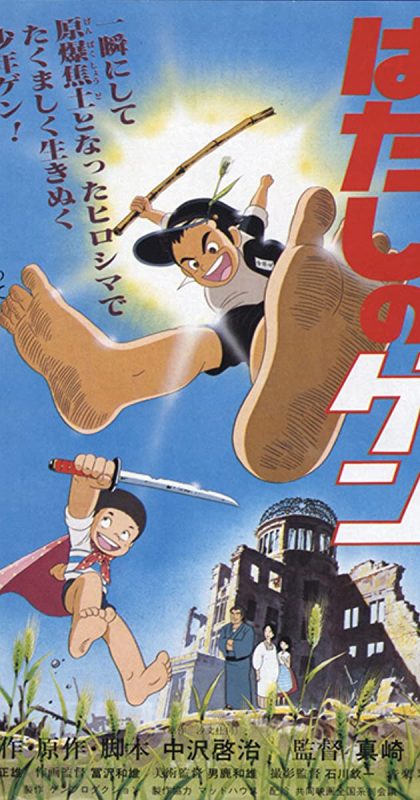By: Samantha Kosai
Today we discussed the atomic bomb, primarily through the first two books of Keiji Nakazawa’s Barefoot Gen series. These books follow a closely-autobiographical journey of a boy named Gen and his family right before the atomic bomb drops on their hometown, Hiroshima, and its aftermath. Nakazawa writes in the form of a comic series; we read the first two and saw the 1983 animated movie. When we discussed the animated film, Lela brought up an excellent point about the use of animation in depicting the initial moments after the bomb drops. The horrific effects of the bomb slowly paint onto Hiroshima civilians and leave them looking somewhat like zombies.

This is the movie cover for the 1983 animated version we saw in class.
The class agreed that animation was able to show the destruction of the atomic bomb in a manner that allowed viewers to recognize and grieve its effects while not being too gory, like what might happen in a live-action remake. Bright colors and cutting between freeze-framed scenes also let viewers take in the damage done to Hiroshima victims in ways that are particular to an animated style. We discussed the differences between Barefoot Gen and “A Grave of Fireflies,” which we read Friday. We also read an article by Susan Napier that compares the two and agreed with her argument that both have different tones. Keenan shared that Barefoot Gen has an overall more uplifting tone that is reflected in Gen processing the war by taking care of his mom and younger sister, the only other survivors of his family. This reinforces a distinction Napier makes about victimhood and suffering. By being the latter, Gen does not enable victim consciousness to form.

This is the Hiroshima Peace Memorial Park.
We read two other articles about Hiroshima and the Peace Memorial Park. An article by Rinjiro Sodei posed the question: “Is the A-bomb known more for its power or misery?” which I asked the class as well. Keenan answered that it depends on who you are asking and the rest of the class agreed. The atomic bomb is internationally known but means different things based on your relation to the history of the war. I thought this was a really great point. We also read Ran Zwigenberg’s article and focused on the ethics of preserving the A-bomb dome, the use of calling the park sacred in political discussions, and student protests. One of the biggest takeaways I got from this part of our discussion was Lela’s recognition that it is not really our place to decide the ethics of how these issues are handled since we are not part of those communities. This is an important thing to remember as we continue to study history and go forward in creating it.
I am working with Gabriel Galanti for our research project to study the depiction of comfort women in the Korean film Spirits’ Homecoming. This film is critical of the discriminatory actions comfort women faced and those who reinforce this system. We finished a draft of our paper last week and submitted it to Professor Uchiyama in lieu of a preliminary research plan to receive feedback on our work. It has been really nice working with Gabe; he is very dedicated to both this project and being a responsible and communicative writing partner. I’m looking forward to reading Professor Uchiyama’s comments and revising our paper based on them.
